Uniform Circular-Array-Based Borehole Pulsed Eddy-Current System for Asymmetry Defect Inspection in Downhole Casings
Abstract
:1. Introduction
2. Borehole PEC Model
3. Synthesized UCA-Based Asymmetry Defect Inspection in Metal Casings
3.1. Synthesized UCA-Based Borehole PEC System
3.2. 3D Dataset of the Borehole PEC Array
4. Asymmetry Defect Inspection Using Azimuth-Time Data of the Synthesized UCA
5. Simulations and Experiments
5.1. Indoor Experiments
5.2. Field Experiment Discussion
6. Conclusions
Author Contributions
Funding
Institutional Review Board Statement
Informed Consent Statement
Data Availability Statement
Acknowledgments
Conflicts of Interest
References
- Brill, T.M.; Shaposhnikov, P.; Valstar, D.; Singh, K. Well integrity evaluation using acoustic and electromagnetic measurements. Lead. Edge 2022, 41, 122–133. [Google Scholar] [CrossRef]
- Salem, A.M.; Yakoot, M.S.; Mahmoud, O. Addressing Diverse Petroleum Industry Problems Using Machine Learning Techniques: Literary Methodology—Spotlight on Predicting Well Integrity Failures. ACS Omega 2022, 7, 2504–2519. [Google Scholar] [CrossRef] [PubMed]
- Zhu, P.; Li, Z.; Chen, M.; Dong, Y. Study on forward and inversion modeling of array laterolog logging in a horizontal/highly deviated well. Acta Geophys. 2019, 67, 1307–1318. [Google Scholar] [CrossRef]
- Wilt, M.J.; Um, E.S.; Nichols, E.; Weiss, C.J.; Maclennan, K. Casing Integrity Mapping using Top-Casing Electrodes and Surface Based Electromagnetic Fields. Geophysics 2019, 85, 1–51. [Google Scholar] [CrossRef]
- Ewy, R.T. Well Shear Associated with Conventional and Unconventional Operations: Diagnosis and Mechanisms. SPE Drill. Completion 2021, 36, 427–444. [Google Scholar] [CrossRef]
- Liu, Y.; Xing, X.; Wang, Y.; Xu, W.; Liu, K.; Lv, Y. Application of Downhole Camera Technology in Fault Diagnosis of Coalbed Methane Wells. J. Phys. Conf. Ser. 2021, 1894, 012046. [Google Scholar]
- Ashby, S.; Al-Shamrani, S.; Hansen, J.; Almutairi, T.; AI-Mulhim, A. Coiled tubing conveyed video camera and multi-arm caliper liner damage diagnostics post plug and perf frac. In Proceedings of the SPE Milddle East Oil & Gas, Manama, Bahrain, 8–11 March 2015. [Google Scholar] [CrossRef]
- Gao, X.; Shi, Y.; Zhu, Q.; Li, Z.; Zhang, W. Domain Adaptation in Intelligent Ultrasonic Logging Tool: From Microseismic to Pulse-Echo. IEEE Trans. Instrum. Meas. 2021, 70, 2505014. [Google Scholar] [CrossRef]
- Um, E.S.; Commer, M.; Newman, G.A.; Hoversten, G.M.M. Finite element modelling of transient electromagnetic fields near steel-cased wells. Geophys. J. Int. 2015, 202, 901–913. [Google Scholar] [CrossRef] [Green Version]
- Rourke, M.; Jin, Y.; Dong, Q. Algorithm development and case study for a 1-11/16 pulsed eddy current casing inspection tool. In Proceedings of the SPWLA 55th Annual Logging Symposium, Abu Dhabi, United Arab Emirates, 18–22 May 2014. [Google Scholar]
- Le, M.; Wang, D.; Luong, V.S.; Lee, J.; Joo, S.H. Cylinder-type magnetic cameras and their coverage performance evaluation for inspection of heat exchanger tubes. J. Inst. 2020, 15, P12031. [Google Scholar] [CrossRef]
- Zeghlache, M.L.; Noui-Mehidi, M.; Rourke, M.; Ismail, M. Enhanced time domain EM technology for multiple casing corrosion monitoring. In Proceedings of the Abu Dhabi International Petroleum Exhibition, Abu Dhabi, United Arab Emirates, 9 November 2020. [Google Scholar]
- Jawed, R.; Maheshwari, K.; Jamali, J.; Rourke, M. Through tubing casing break detection: An EM thickness tool application. In Proceedings of the SPE Canada Heavy Oil Conference, Calgary, AB, Canada, 29 September–2 October 2020. [Google Scholar]
- Wang, C.; Wu, S.; Xin, J.; He, R.; Wang, D. Numerical simulation of oil and gas pipeline crack detection based on pulsed eddy current testing technology. In Proceedings of the 4th International Conference on Electron Device and Mechanical Engineering (ICEDME), Guangzhou, China, 19–21 March 2021. [Google Scholar] [CrossRef]
- Akbari-Khezri, A.; Sadeghi, S.H.H.; Moini, R.; Sharifi, M. An Efficient Modeling Technique for Analysis of AC Field Measurement Probe Output Signals to Improve Crack Detection and Sizing in Cylindrical Metallic Structures. J. Nondestr. Eval. 2016, 35, 9. [Google Scholar] [CrossRef]
- Bowler, J.R.; Theodoulidis, T. Boundary Element Calculation of Eddy Currents in Cylindrical Structures Containing Cracks. IEEE Trans. Magn. 2009, 45, 1012–1015. [Google Scholar] [CrossRef]
- Kozhevnikov, N.O.; Antonov, E.Y.; Kamnev, Y.K.; Olenchenko, V.V.; Plotnikov, A.E.; Stefanenko, S.M.; Shein, A.N. Effects of borehole casing on TEM response. Russ. Geol. Geophys. 2014, 55, 1333–1339. [Google Scholar] [CrossRef]
- Xue, Z.A.; Fan, M.B.; Cao, B.H.; Wen, D.D. A fast numerical method for the analytical model of pulsed eddy current for pipelines. Insight—Non-Destr. Test. Cond. Monit. 2020, 62, 27–33. [Google Scholar] [CrossRef]
- Theodoulidis, T.; Skarlatos, A. Efficient calculation of transient eddy current response from multi-layer cylindrical conductive media. Phil. Trans. R. Soc. A 2020, 378, 20190588. [Google Scholar] [CrossRef]
- Ulapane, N.; Thiyagarajan, K.; Hunt, D.; Miro, J.V. Quantifying the Relative Thickness of Conductive Ferromagnetic Materials Using Detector Coil-Based Pulsed Eddy Current Sensors. J. Vis. Exp. 2020, 155, e59618. [Google Scholar] [CrossRef] [PubMed]
- Dutta, S.; Iqbal, P.; Olaiya, J.; Hughes, B. Multi-sensor time-domain electromagnetic measurements for quantitative evaluation of multi-barrier corrosion. In Proceedings of the SPE Asia Pacific Oil & Gas Conference and Exhibition, Perth, Australia, 12 November 2020. [Google Scholar] [CrossRef]
- Ulapane, N.; Nguyen, L. Review of Pulsed-Eddy-Current Signal Feature-Extraction Methods for Conductive Ferromagnetic Material-Thickness Quantification. Electronics 2019, 8, 470. [Google Scholar] [CrossRef] [Green Version]
- Rifai, D.; Abdalla, A.N.; Ali, K.; Razali, R. Giant Magnetoresistance Sensors: A Review on Structures and Non-Destructive Eddy Current Testing Applications. Sensors 2016, 16, 298. [Google Scholar] [CrossRef] [Green Version]
- Rocha, T.J.; Ramos, H.G.; Lopes Ribeiro, A.; Pasadas, D.J.; Angani, C.S. Studies to optimize the probe response for velocity induced eddy current testing in aluminium. Measurement 2015, 67, 108–115. [Google Scholar] [CrossRef]
- Dang, B.; Yang, L.; Liu, C.Z.; Zheng, Y.H.; Li, H.; Dang, R.R.; Sun, B.Q. A Uniform Linear Multi-Coil Array-Based Borehole Transient Electromagnetic System for Non-Destructive Evaluations of Downhole Casing. Sensors 2018, 18, 2707. [Google Scholar] [CrossRef] [Green Version]
- Dang, B.; Liu, C.Z.; Yang, L.; Wang, G.; Wang, M.M.; Ren, Z.P.; Dang, R.R. EMD-based Borehole TEM Array Signal Denoising and Baseline Wander Correction for NDT of Downhole Casings. IEEE Access 2020, 99, 1. [Google Scholar] [CrossRef]
- Liu, C.Z.; Dang, B.; Wang, H.Y.; Shen, X.H.; Yang, L.; Ren, Z.P.; Dang, R.R.; Kang, Y.Z.; Sun, B.Q. Multiple-Transmit Focusing for the Nondestructive Testing of Downhole Casings Based on Borehole Transient Electromagnetic Systems. IEEE Access 2020, 8, 210978. [Google Scholar] [CrossRef]
- Fu, Y.; Yu, R.; Peng, X.; Ren, S. Investigation of casing inspection through tubing with pulsed eddy current. Nondestruct. Test. Eval. 2012, 27, 353–374. [Google Scholar] [CrossRef]
- Wu, T.; Bowler, J.R.; Theodoulidis, T.P. Eddy-Current induction by a coil whose axis is perpendicular to that of a Tube. IEEE Trans. Magn. 2017, 53, 1–9. [Google Scholar] [CrossRef]
- Zhou, H.T.; Hou, K.; Pan, H.L.; Chen, J.J.; Wang, Q.M. Study on the optimization of eddy current testing coil and the defect detection sensitivity. Procedia Eng. 2015, 130, 1649–1657. [Google Scholar] [CrossRef] [Green Version]
- Bai, Y.; Zhan, Q.W.; Wang, H.N.; Chen, T.; He, Q.L.; Hong, D.C. Calculation of Tilted Coil Voltage in Cylindrically Multilayered Medium for Well Logging Applications. IEEE Access 2020, 99, 1. [Google Scholar] [CrossRef]
- Marinov, S.G. Theoretical and experimental investigation of eddy current inspection of pipes with arbitrary position of sensor coils. In Review of Progress in Quantitative Nondestructive Evaluation; Thompson, D.O., Chimenti, D.E., Eds.; Springer: Boston, MA, USA, 1986; Volume 5A, pp. 225–232. [Google Scholar] [CrossRef] [Green Version]
- Yang, Q.N.; Xie, S.J.; He, K.; Chen, Y.; Chen, Z.M.; Uchimoto, T.; Takagi, T. A novel circumferential eccentric eddy current probe and its application for defect detection of small-diameter tubes. Sens. Actuators A Phys. 2021, 331, 113023. [Google Scholar] [CrossRef]
- Rifai, D.; Abdalla, A.N.; Razali, R.; Ali, K.; Faraj, M.A. An Eddy Current Testing Platform System for Pipe Defect Inspection Based on an Optimized Eddy Current Technique Probe Design. Sensors 2017, 17, 579. [Google Scholar] [CrossRef] [Green Version]

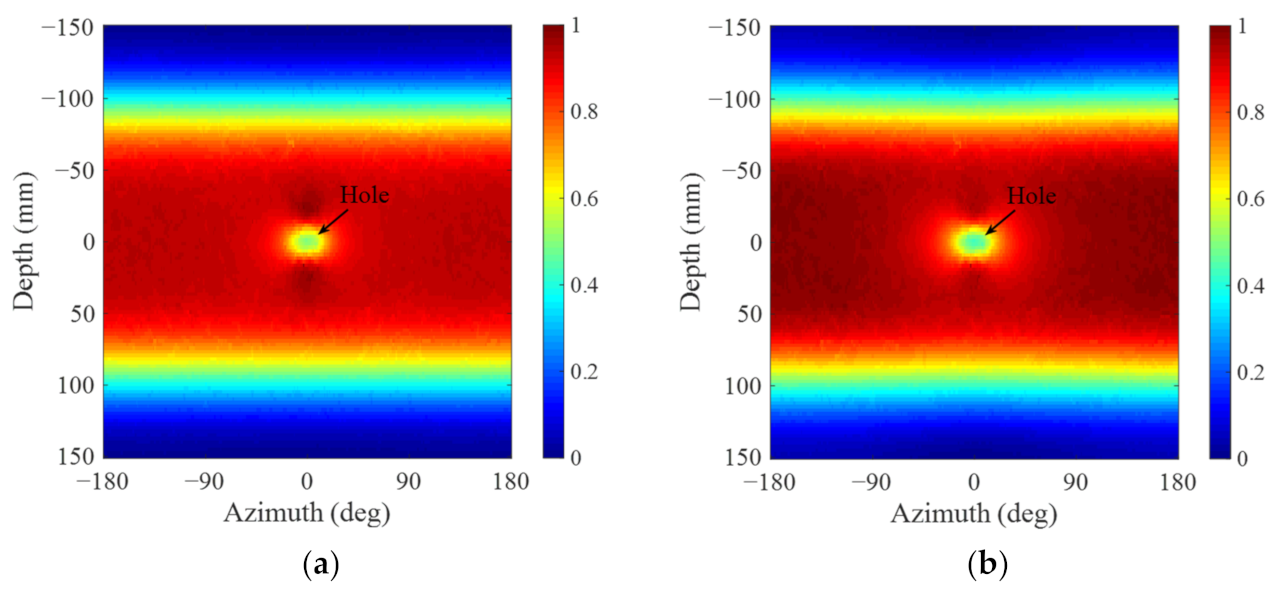

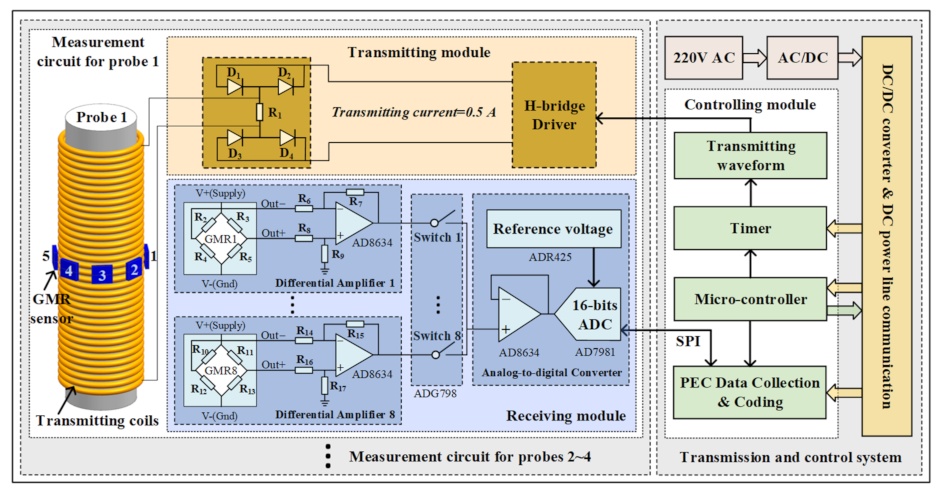
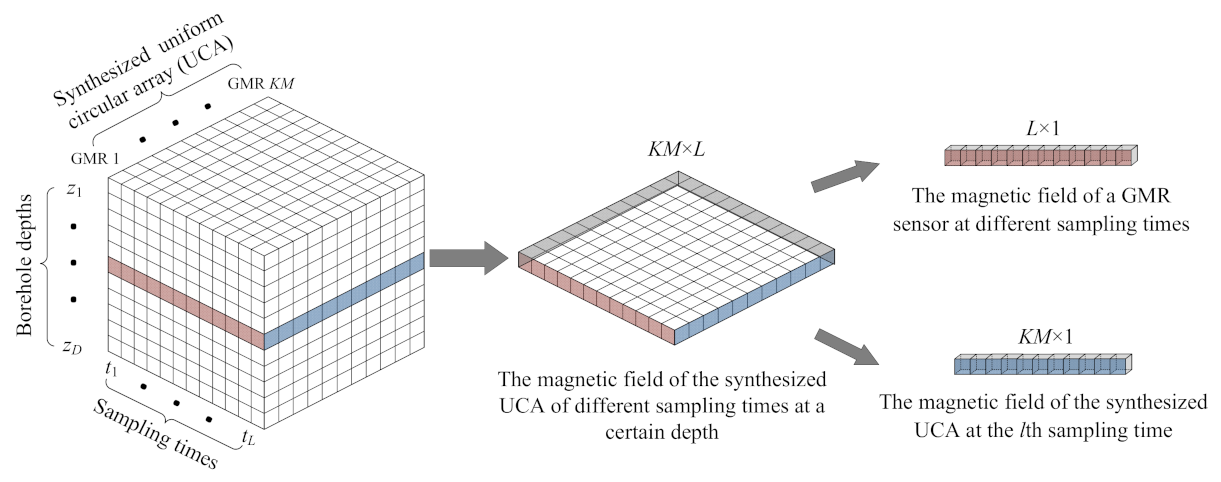
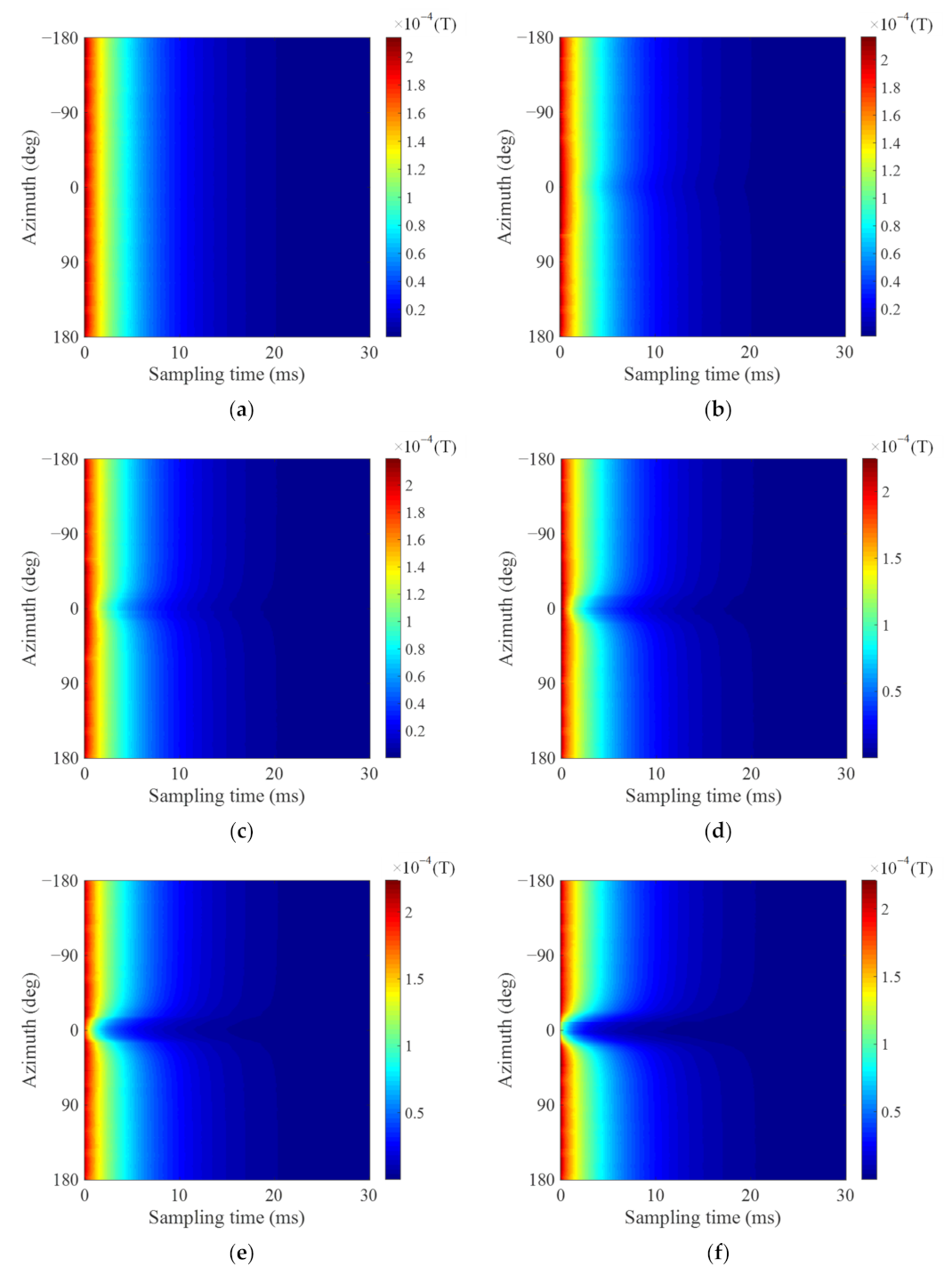

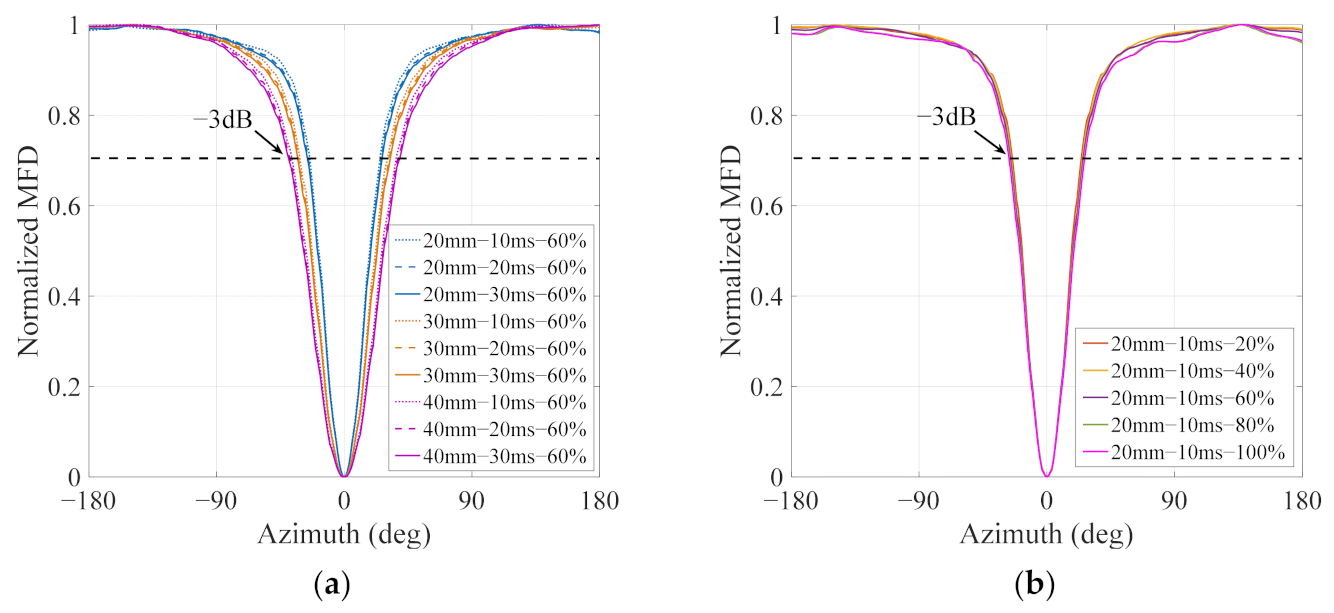

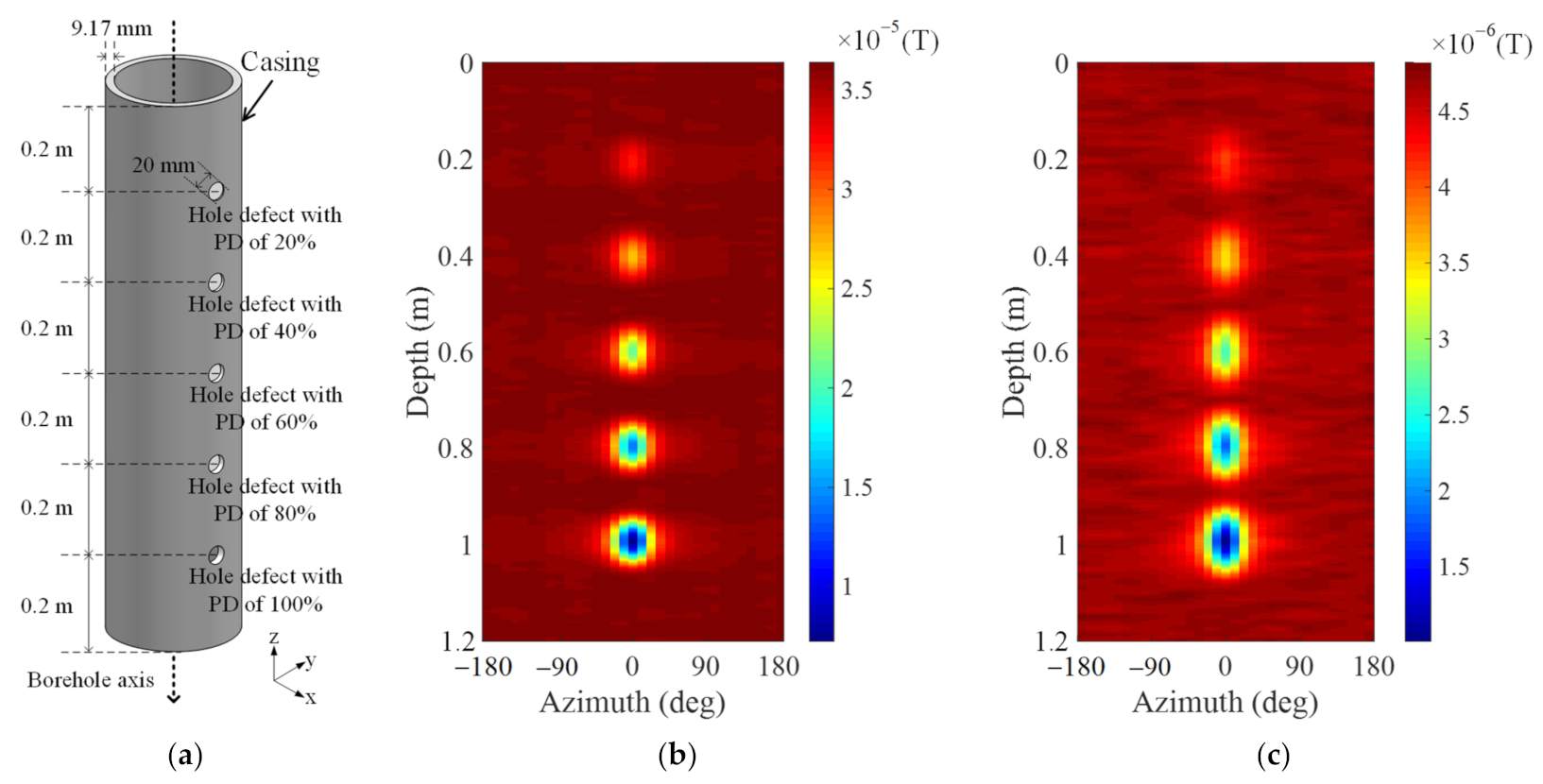
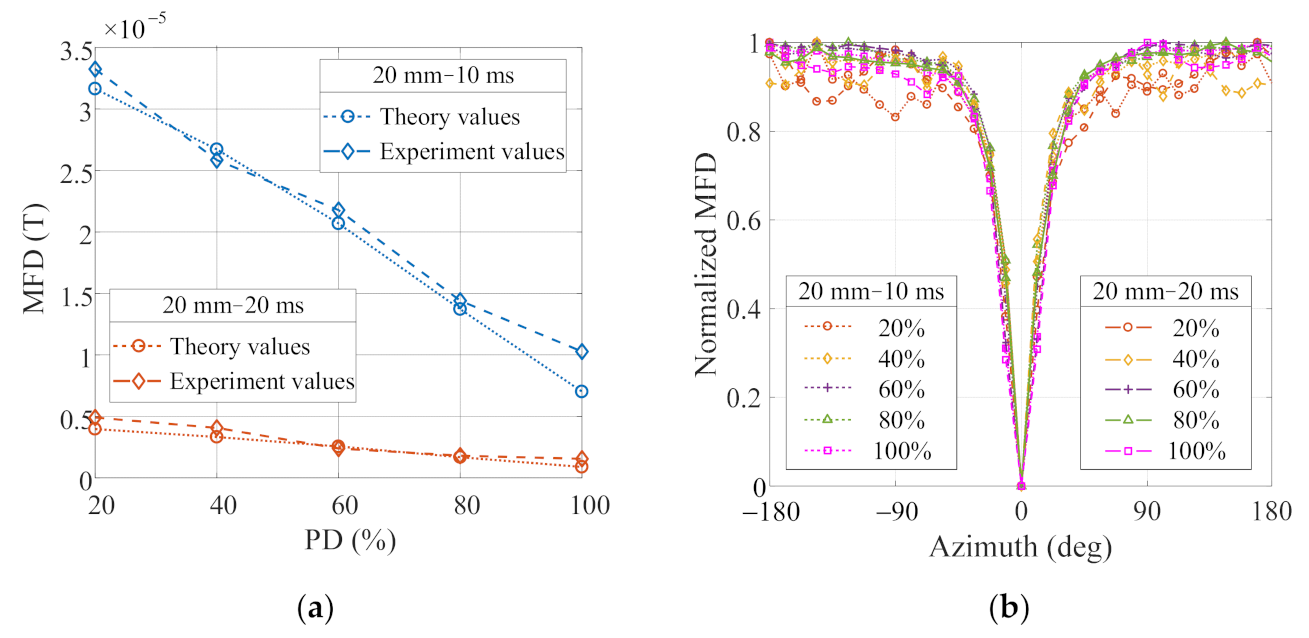

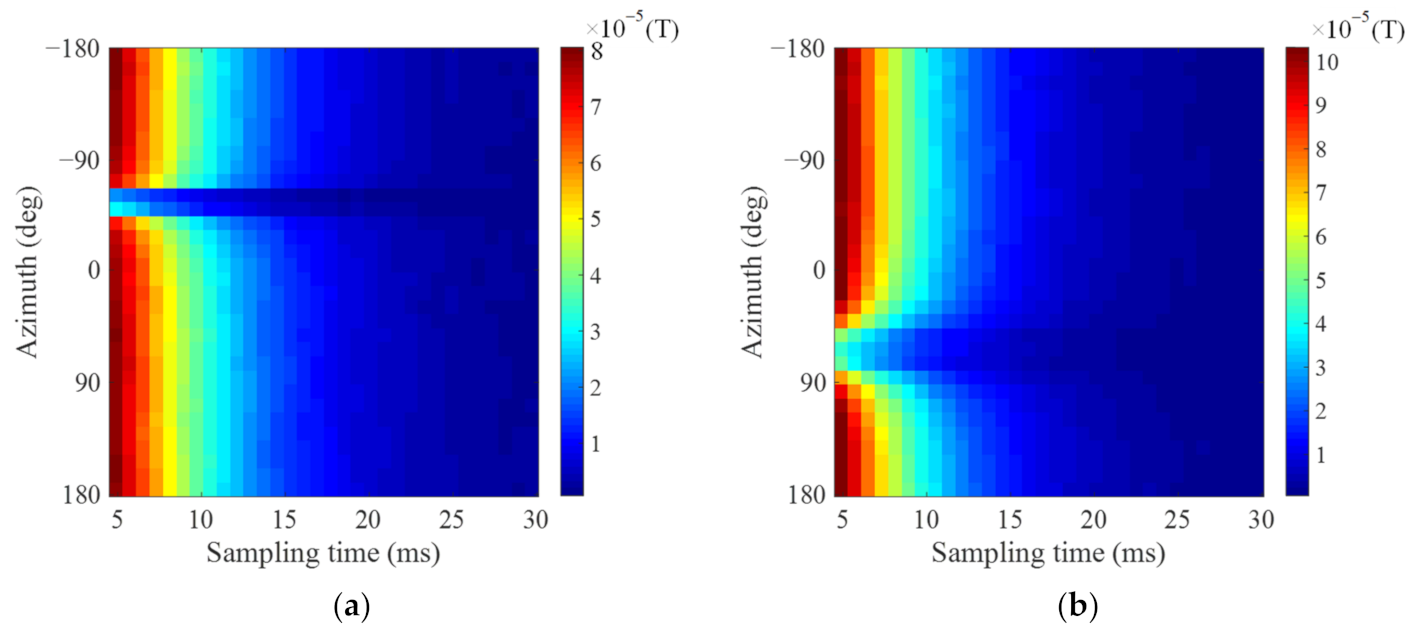


Publisher’s Note: MDPI stays neutral with regard to jurisdictional claims in published maps and institutional affiliations. |
© 2022 by the authors. Licensee MDPI, Basel, Switzerland. This article is an open access article distributed under the terms and conditions of the Creative Commons Attribution (CC BY) license (https://creativecommons.org/licenses/by/4.0/).
Share and Cite
Yang, L.; Dang, B.; Ren, Z.; Liu, C.; Dang, J.; Zhao, Y.; An, B.; Dang, R. Uniform Circular-Array-Based Borehole Pulsed Eddy-Current System for Asymmetry Defect Inspection in Downhole Casings. Electronics 2022, 11, 2030. https://doi.org/10.3390/electronics11132030
Yang L, Dang B, Ren Z, Liu C, Dang J, Zhao Y, An B, Dang R. Uniform Circular-Array-Based Borehole Pulsed Eddy-Current System for Asymmetry Defect Inspection in Downhole Casings. Electronics. 2022; 11(13):2030. https://doi.org/10.3390/electronics11132030
Chicago/Turabian StyleYang, Ling, Bo Dang, Zhiping Ren, Changzan Liu, Jingxin Dang, Yang Zhao, Baixin An, and Ruirong Dang. 2022. "Uniform Circular-Array-Based Borehole Pulsed Eddy-Current System for Asymmetry Defect Inspection in Downhole Casings" Electronics 11, no. 13: 2030. https://doi.org/10.3390/electronics11132030
APA StyleYang, L., Dang, B., Ren, Z., Liu, C., Dang, J., Zhao, Y., An, B., & Dang, R. (2022). Uniform Circular-Array-Based Borehole Pulsed Eddy-Current System for Asymmetry Defect Inspection in Downhole Casings. Electronics, 11(13), 2030. https://doi.org/10.3390/electronics11132030





